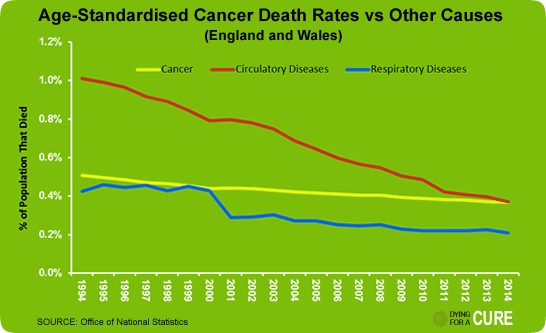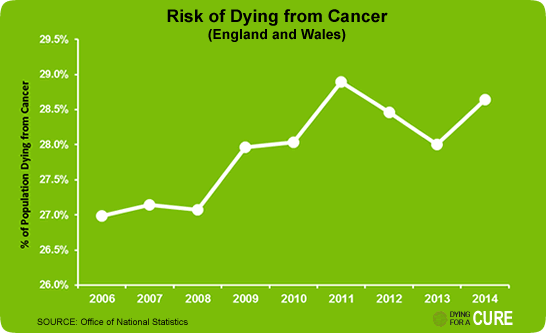Are We Being Misled On Cancer Progress?
survival rates don’t prove that cancer patients are living longer; mainly that they are living with cancer for longerEvidence has come to light that the public may be being misled about our progress in beating cancer and that progress is almost certainly not as good as that implied by the much touted cancer survival statistics.
This month Cancer Research UK published its Annual Review for 2015/16. It boldly claims that “Thanks to research, survival rates are increasing. Right now, one in two people survive cancer.” It goes on to say “We’ve helped double cancer survival in the last 40 years”. This sounds like great progress and would certainly reassure the public that we’re on track to beat cancer and encourage everyone to keep donating. But while there is little doubt that we have made some progress, dig beneath the spin and you’ll find that everything in the garden is not as rosy at it seems.
Firstly, there is a strong inference from these claims that ‘cancer survivors’ have actually beaten cancer, when in fact many ‘survivors‘ still have cancer or are living with debilitating side-effects from the treatment. Sadly there are no published statistics on how many patients have genuinely beaten cancer and are in long-term remission, which is surely what patients really want. Instead, the survival statistics used to support claims of progress simply measure how many people are still alive 5 or 10 years after being diagnosed with cancer. Unfortunately these survival rates don’t prove that cancer patients are living longer; mainly that they are living with cancer for longer.
Secondly, there is also an inference that survival rates are improving solely as a direct consequence of investment in research, rather than earlier diagnosis.
“changes in 5-year survival rate over time bear little relationship to changes in cancer mortality” - Welch, Schwartz & Woloshin, June 2000
The use of survival rates as a way of measuring progress was found to be flawed over 15 years ago, after a major study of cancer survival rates examined data over a 45 year period found that “changes in 5-year survival rate over time bear little relationship to changes in cancer mortality.” Despite this, survival rates are still being used today as the headline measures of progress for beating cancer. Also, they are often quoted without making clear that the figures only measure survival over a relatively short period of time, giving the impression that they represent how many people have actually been cured.
The aforementioned study noted that “The 5-year survival rate is perhaps the most common statistic used to report progress in the war against cancer… [It] is often presented to the public as evidence of the value of cancer research and early detection”.
However, the study concluded that “Comparisons of 5-year survival rates across time may be extremely misleading…The relationship between temporal trends in 5-year survival and the effectiveness of cancer care may be, at best, tenuous.”
WHAT MAKES SURVIVAL RATES “EXTREMELY MISLEADING”?
The main reason that survival rates overstate progress is due to the fact that they don’t simply depend on when someone dies but also on when their cancer is detected. Earlier detection will therefore always lead to improved survival rate statistics, even if it doesn’t lead to delayed death. This effect is known as “lead-time bias” and is explained very clearly in the following video.
However, survival rates can also be inflated significantly by an effect known as “overdiagnosis”. This happens when improved screening detects cancers earlier, which may not go on to develop symptoms that need treating or which grow so slowly that the patient would have outlived the cancer and died of something else before cancerous symptoms appeared. Again, this is explained well in the following video.
MORTALITY RATES AS AN ALTERNATIVE MEASURE OF PROGRESS
Because of the flaws of using survival rates to measure progress with beating cancer, the authors of the study recommended that it is better to measure progress in beating cancer by looking at death rates rather than survival rates. So, what if we look at cancer death rates – do these show that we are making progress? Well, Yes and No.
The good news is that although the number of people dying from cancer has risen over the last 20- years, cancer death rates, which take into account population growth, have steadily declined. However, so too have death rates for other causes of death, so the reductions in cancer deaths could be partly due general improvements in healthy lifestyles and not necessarily the result of improved cancer treatments.
The Dying for a Cure campaign carried out an analysis of registered deaths published by the Office of National Statistics and found that death rates for cancer over the last 20 years improved by much less than the deaths rates for the other two major groups of diseases; circulatory and respiratory.

The poor progress on cancer compared with other diseases means that the risk of dying of cancer has actually increased over the last decade.

In fact, the risk of dying from cancer has risen for almost all age groups since 2006.

Is this what the public would expect when they read claims like “thanks to cancer research, cancer survival rates have doubled in the last 40 years” and “today, half of people diagnosed with cancer will survive”.
We all want to see the day when we no longer live in fear of cancer and we should certainly commend real progress in moving forward towards this goal, but we need to be honest about how well we are doing and avoid using misleading statistics to present the facts in a more attractive light. Exaggerating progress is particularly offensive to anyone who has lost someone to cancer or is currently battling cancer. And it is also tantamount to mis-selling for people who raise money to ‘beat cancer‘.
The bottom line is that survival rates alone are not proof of progress – in an era of evidence based medicine, we need evidence based statistics. Survival rates underpin so many of the decisions that we are making – what drugs to give patients, what research to carry out, what charities we raise money for, what our entire cancer strategy should be – so, we need reliable measures of success, as at the end of the day lives depend on knowing how well we are doing.
cancer as a disease is growing faster than the solutions we’re developing for itThe hard truth is that more people are dying of cancer than ever before, more people are living with cancer and the debilitating side-effects of treatments, and the likelihood of dying of cancer appears to increasing, as progress with cancer is lagging behind progress with other diseases. As it currently stands, cancer as a disease is growing faster than the solutions we’re developing for it.
Meanwhile, the British public contributes a massive £2.5bn a year towards the costs of developing new treatments for cancer, drug companies make double-digit profit margins, higher than any other major industry on the planet and half of the new treatments being developed are too expensive for routine use by the NHS.
It is fairly obvious that while people make huge profits from research, we are more likely to beat cancer later than beat cancer sooner, as there is little incentive to accelerate progress. If we want better results we need a whole new approach to investment in research and development that rewards genuine innovation, instead of simply awarding drug companies 20-year monopolies for new drugs that do very little.
A New Approach to Cancer Research and Development
The Dying for a Cure campaign is calling on the UK Government to work with other countries and the World Health Organisation to develop alternative approaches to funding research and development for new treatments, with the aim of encouraging greater innovation, so we do actually beat cancer sooner.
One promising alternative approach, known as ‘delinkage‘, involves separating the process of developing a new drug from the process of manufacturing it, so that these two processes can be funded in different ways. Under this approach, research and development costs would be funded directly from a pooled international fund, instead from monopoly premiums added to drug manufacturing costs, as they are now. This offers the potential to set improved rewards and incentives, which could significantly speed up innovation and also radically improve access to new medicines, as prices for new medicines would be much lower.
Reforms like this make sense to anyone not profiting from the current system of cancer research but as faster progress means less money can be made, there will be plenty of people who are happy to leave things as they are, even though this means fewer lives saved.
So, we need your help. Please help us encourage the Government to take the steps that are needed to implement cancer reforms like this by signing our petition.

